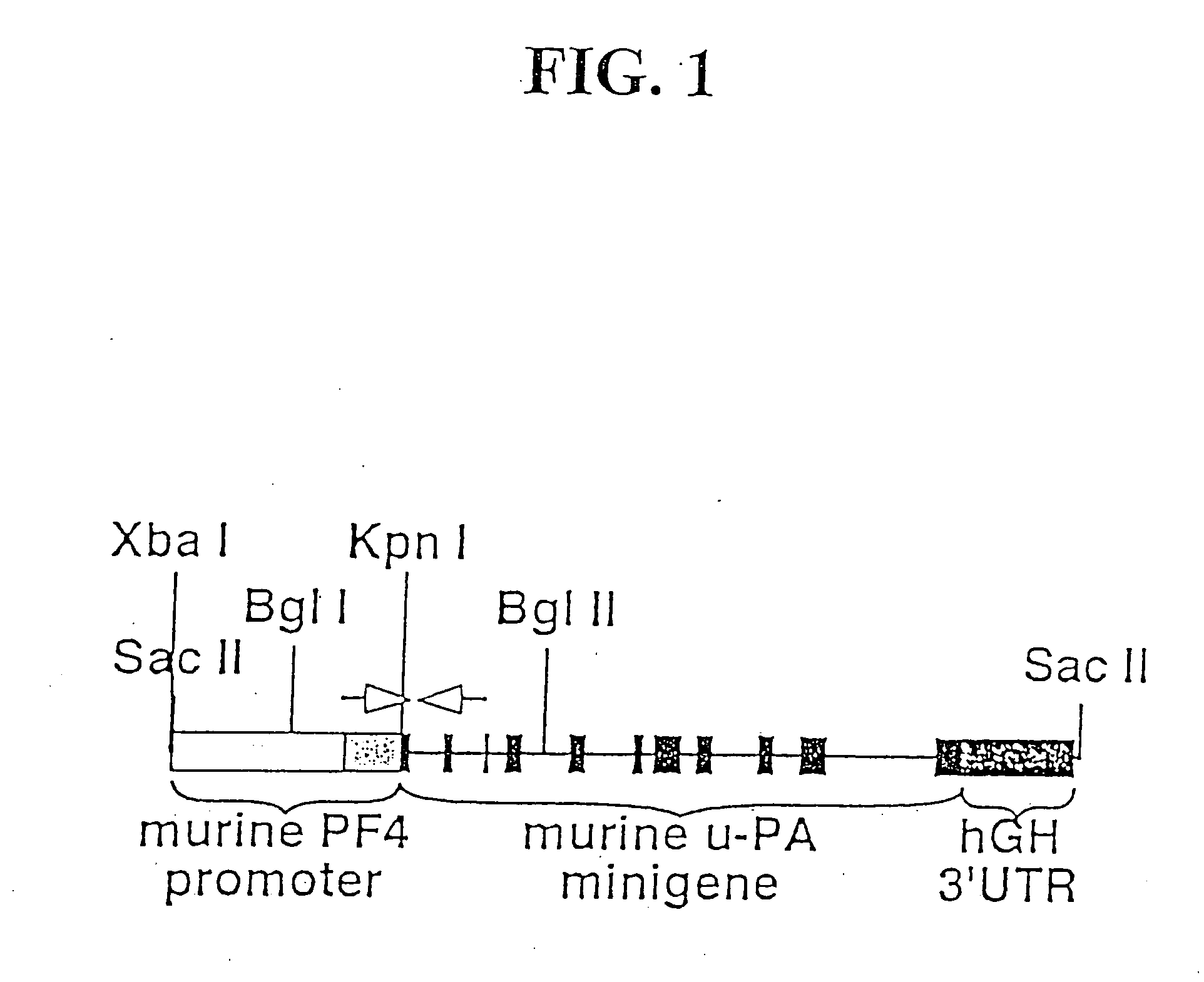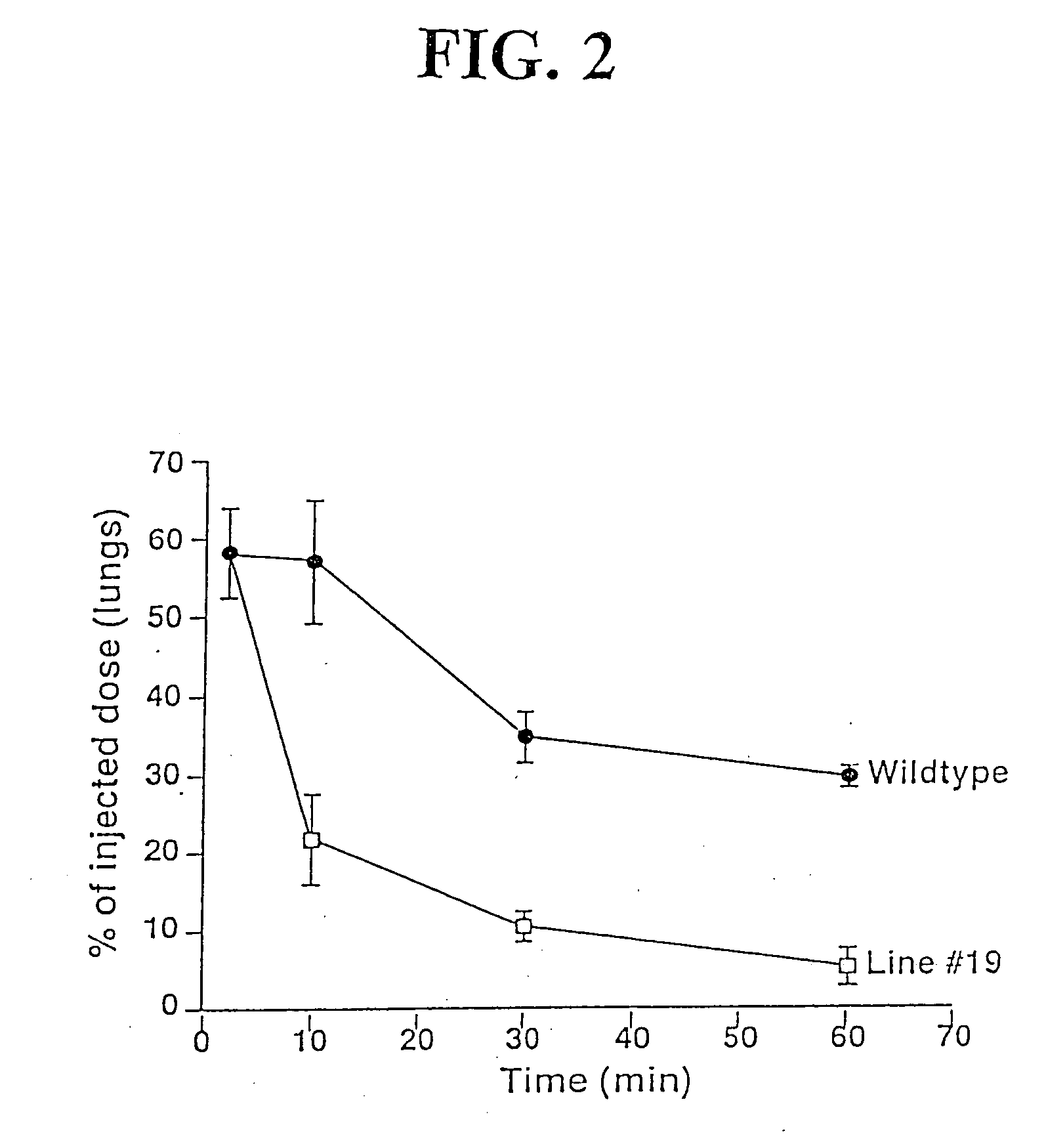Delivery vehicle for recombinant proteins
a technology of recombinant proteins and delivery vehicles, which is applied in the direction of peptides, chemokines, blood/immune system cells, etc., can solve the problems of thrombosis and protein levels at very low levels, and achieve the effect of preventing unwanted thrombosis
- Summary
- Abstract
- Description
- Claims
- Application Information
AI Technical Summary
Benefits of technology
Problems solved by technology
Method used
Image
Examples
example 1
Establishment of Transgenic Mice Expressing U-PA Message
[0111] A transgene was designed as illustrated schematically in FIG. 1. 1.2 kb of the 129 SV murine platelet factor 4 (PF4) proximal promoter region plus its 5′ untranslated region (UTR) (Zhang, C. et al, 2001 Blood 98:610-607) was PCR amplified with an artificial upstream Xba I site and a downstream Kpn I site added. The inventors found that this promoter could also drive megakaryocyte-specific expression of LacZ in transgenic mice (data not shown). This promoter was inserted in place of the albumin enhancer / promoter immediately upstream of a mouse u-PA minigene construct that contained a 3′-UTR and poly-adenylation sequence from the human growth hormone (hGH) gene. This construct was previously described in Heckel, J. L. et al, 1990 Cell 62:447-456, which is incorporated by reference herein.
[0112] A 10.2 kb Sac II fragment containing this construct was used to create transgenic mice by pronuclear injections following standa...
example 2
Transgenic U-PA Message Detection
[0119] The animals of Example 1 were then examined to determine whether they expressed u-PA in their platelets. Murine platelet RNA was isolated using RNA STAT-60™ (Tel-Test, Friendswood, Tex.) as previously described (Zhang, C. et al, cited above). Tissues (˜100 mg each) from these animals were collected, rinsed vigorously with saline, disaggregated in 500 μl of RNA STAT-60™, and RNA was isolated (Zhang, C. et al, cited above). Some platelet RNA samples were pretreated with DNase free RNase (1 U / 10 μl reaction, Sigma, St. Louis, Mo.) or RNase free DNase (1 U / 10 μl reaction, Life Technologies, Gaithersburg, Md.) for 1 hour at 37° C.
[0120] Reverse transcription was performed using the SuperScript II Reverse Transcriptase Kit™ (Life Technologies) as per the manufacturer's instructions. PCR amplification of the transgenic u-PA cDNA was accomplished using the two primers discussed above. Platelet-specific control RT-PCR primers for PF4 message were sen...
example 3
Immunogistochemical Staining for Murine Urokinase
[0122] Spleen and bone marrow aspirates from wildtype and murine u-PA transgenic mice were stained for murine u-PA expression using a mouse monoclonal anti-murine u-PA antibody (A10, Molecular Innovations, Inc., Southfield, Mich.) as the primary antibody and a biotinylated anti-mouse immunoglobulin (ARK detections system, DAKO, Caprinteria, Calif.) as the secondary antibody. Specifically, formalin-fixed, paraffin-embedded 5 μm sections were deparaffinized in xylene and rehydrated. Endogenous peroxidase activity was quenched with 0.9% peroxide in methanol for a total of 20 minutes. Slides were then treated with trypsin (1 mg / ml in PBS) for 10 minutes at 37° C. After incubation of the monoclonal anti-murine u-PA antibody (0.5 μg / ml) with biotinylated ARK reagent (according to manufacturer's instructions) for 15 minutes at room temperature, the slides were stained at room temperature for 2 hours. Slides were washed and incubated with St...
PUM
| Property | Measurement | Unit |
|---|---|---|
| diameter | aaaaa | aaaaa |
| temperature | aaaaa | aaaaa |
| temperature | aaaaa | aaaaa |
Abstract
Description
Claims
Application Information
 Login to View More
Login to View More - R&D
- Intellectual Property
- Life Sciences
- Materials
- Tech Scout
- Unparalleled Data Quality
- Higher Quality Content
- 60% Fewer Hallucinations
Browse by: Latest US Patents, China's latest patents, Technical Efficacy Thesaurus, Application Domain, Technology Topic, Popular Technical Reports.
© 2025 PatSnap. All rights reserved.Legal|Privacy policy|Modern Slavery Act Transparency Statement|Sitemap|About US| Contact US: help@patsnap.com


